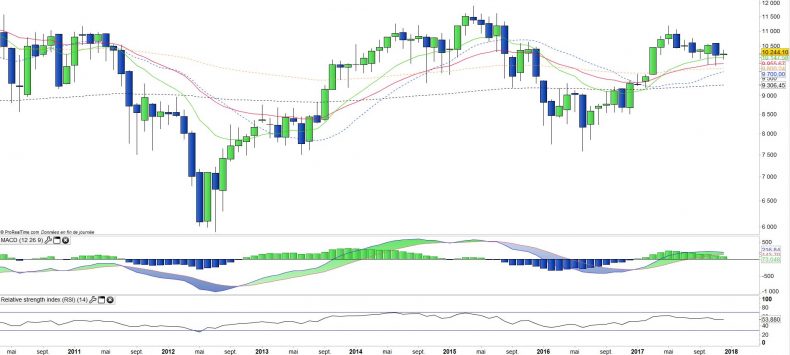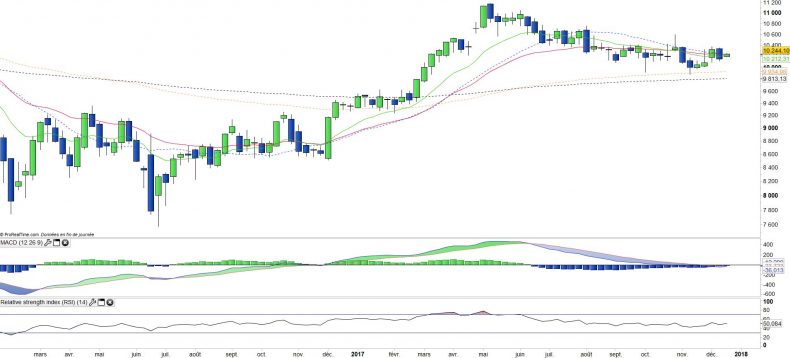Lyxor ETF IBEX (LYXIB) - 19/12/2017
Short Term strategy : Negative (30%) / Trend =
Long Term strategy : Positive (70%) / Trend =
Characteristics of the ETF
ETF LYXIB (Lyxor) replicates the Spanish index, which is composed of the country's top 35 stocks, and is weighted according to the market capitalization and adjusted according to the liquidity of each company included in the index.
The expenses of the ETF LYXIB are 0.3%, in line with the average observed for these products, while the AUM reach approximately 1102M €. Replication is direct (physical) and there is a dividend distribution on a half-yearly basis.
Alternative ETFs: DXIBD (DX-Deutsche Bank), EWP (iShares in USD)
Index & components
This index, like that of Italy, has the particularity of being heavily overweighted in financials, which represent about one-third (35%) of its composition (against around 20% for stoxx600), including Banco Santander, BBVA and Caixa Bank, while that alongside industry (14%), consumer goods represent a significant weight (12%) which is mainly due to Inditex which weighs more than € 100bn in market capitalization, as well as utilities (13%) in which we find the companies Iberdrola, Ferrovial and Abertis.
The 10 largest capitalisations account for nearly two thirds of the index, in addition to the companies already named they also include telecom giant Telefonica as well as the oil group Repsol.
The IBEX was under pressure in 2016 due to the bad behavior of the European banking sector, and political problems that left Spain in uncertainty for many months and without government, it sees its macroeconomic situation to improve significantly but suffered from its strong exposure to Latin America under pressure for 2 years, which is linked in particular to Brazil and Venezuela. However, the Brazilian economy is expected to come out of recession while Argentina, Colombia and Peru benefit from "pro-business" governments.
The political risks have moved away with a resumption of the government by Mr Rajoy and a relative weakening of the populist "Podemos" big losers of the legislative elections of July 2016.
In 2016, Spain saw its GDP grow by 3.2% keeping thus the same pace as in 2015, a figure well above that of the euro area, which reached 1.7% in 2016 but is accelerating. The fourth largest economy in the eurozone, has recorded its fifteenth consecutive quarter of growth since the end of 2013, after a descent into hell began in 2008 in the aftermath of the real estate and financial crisis. Two factors specific to Spain made possible this sharp rise in GDP which is confirmed in 2017: the recovery of the labor market, whereas between 2013 and the end of 2016, the unemployment rate went from 27% to 18% and 1.2 million jobs were created. The second explanation concerns the profitability of companies which has become one of the best in Europe, which can be explained by the reorientation of Spanish companies towards exports after the collapse of the domestic market. Growth is expected to reach 3.1% this year.
Latest developments
The IBEX fell by 2.2% in 2016 - despite a significant catch-up in December - against + 1.7% for stoxx600 over the whole of 2016, while the volatility is rather high which is due to the strong weighting in financials. After a very good start to the year catalyzed by the rise of banks, the Spanish index stalled from May and returned a good part of its gains. Since the beginning of the year the IBEX35 has increased by only 8.5% (against + 16.3% at the end of May), less than the Stoxx600NR (+ 10.2%).
The Spanish economy is very strong with an expected growth of 3.1% in 2017 but the Catalan referendum has weakened the political situation that was just recovering the setbacks related to the elections of 2016 (absence of government for months). Although the referendum is illegitimate, unconstitutional and refused by Europe, it remains nonetheless that it managed to gather a little less than half of Catalans. The parties ended up agreeing on new elections to be held this week, December 21st. The vote is of particular importance because if the independence parties win the election, it is not sure that the situation will normalize with the Madrid government. A survey conducted by the Center for Sociological Research (CIS), dependent on the Spanish government, estimates that 84.6% of voters are certain to go to vote, while polls predict an extremely tight vote. The separatists could lose their absolute majority: they would together receive 44.4% of the votes and 66 to 67 seats out of 135 - just below the absolute majority of 68 - whereas they had 72 in 2015. The three opposing parties to Independence -Ciudadanos (liberal), Socialist Catalan Party, and Popular Party in power in Madrid- would gather 44.3% of the votes, and win 59 to 60 seats. The elections are so close that no movement could obtain an absolute majority on December 21st. If the separatist parties are in a good position, they could suffer from their divisions and their too vague program. In any case, this election could have a significant impact on the Spanish index if the separatists were finally to win a majority.
Monthly data
The monthly chart shows a long-term trend that is still positive, but tends to lose momentum, which can be seen through the flattening of moving averages and oscillators. The erosion of the index must stop to maintain the upward trend and an impulse must intervene to revive. The end of December should be very instructive on the direction taken in the medium / long term.
It is safer to stay on the side lines for the moment waiting for a positive signal to return to this index.
Weekly data
On the weekly chart, we can see the price rally on the EMA100, natural support that has occurred in recent weeks. However, the support is worked and could be broken in case of bad news from Catalonia or other. On the other hand, a positive impulse would have a very positive impact on the MACD, and the moving averages would crossover upward rather quickly.
The prices are therefore definitely on a pivot point.
ETF Objective
LYXIB is a UCITS ETF which seeks to replicate the benchmark index IBEX 35 Net Return (35 spanish companies)
Characteristics
| Inception date | 19/01/2006 |
| Expense ratio | 0,30% |
| Issuer | Lyxor |
| Benchmark | Indice IBEX 35 Net Return |
| Code/Ticker | LYXIB |
| ISIN | FR0010251744 |
| Currency | € |
| Exchange | Euronext Paris |
| Assets Under Management | 1 100 M€ |
| Replication method | Direct (Physical) |
| PEA (France) | Yes |
| SRD (France) | Yes |
| Dividend | Distribution |
| Currency risk | No |
| Number of Holdings | 35 |
| Global Risk | 4/5 |
Country Breakdown
| Spain | 96% |
| United Kingdom | 3% |
| Luxembourg | 1% |
Sector Breakdown
| Financials | 35% |
| Utilities | 14% |
| Industrials | 14% |
| Consumer Discretionary | 11% |
| Telecom Services | 9% |
| Energy | 6% |
| Information Technology | 5% |
| Others | 6% |
Top Ten Holdings
| Banco Santander | 17% |
| Inditex | 10% |
| Banco Bilbao | 9% |
| Telefonica | 8% |
| Iberdrola | 8% |
| Amadeus IT | 5% |
| Caixa Bank | 4% |
| Repsol | 4% |
| Abertis | 3% |
| Intl Consolidated Airline | 3% |


